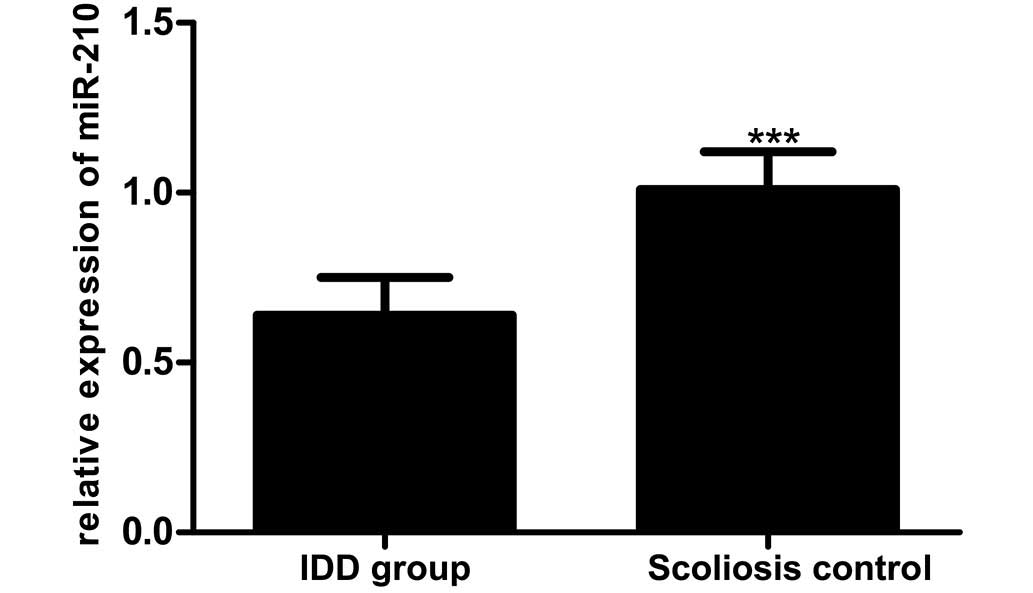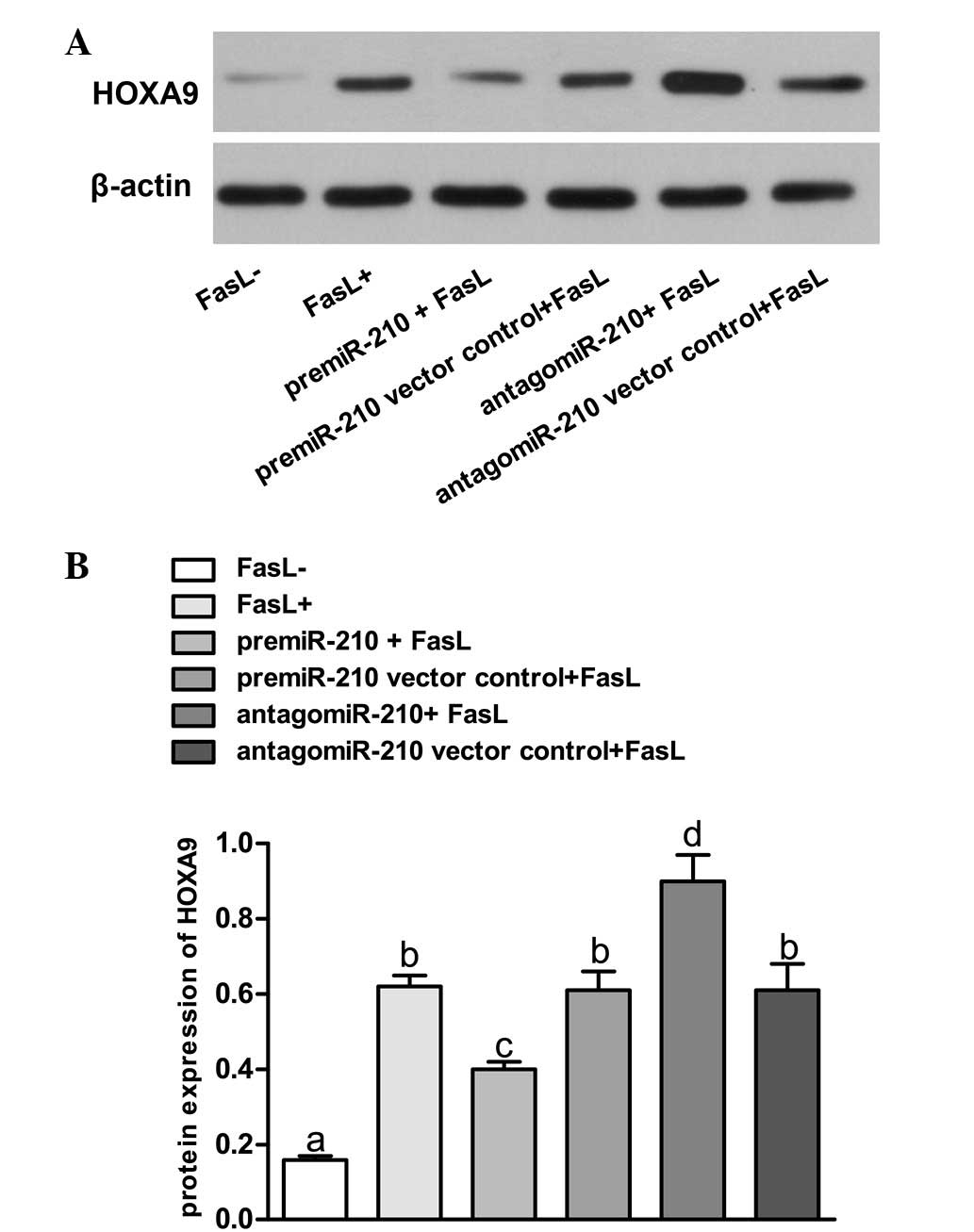|
1
|
Sudo H, Yamada K, Iwasaki K, Higashi H,
Ito M, Minami A and Iwasaki N: Global identification of genes
related to nutrient deficiency in intervertebral disc cells in an
experimental nutrient deprivation model. PLoS One. 8:e588062013.
View Article : Google Scholar : PubMed/NCBI
|
|
2
|
Song YQ, Karasugi T, Cheung KM, Chiba K,
Ho DW, Miyake A, Kao PY, Sze KL, Yee A, Takahashi A, et al: Lumbar
disc degeneration is linked to a carbohydrate sulfotransferase 3
variant. J Clin Invest. 123:4909–4917. 2013. View Article : Google Scholar : PubMed/NCBI
|
|
3
|
Wang YX, Griffith JF, Zeng XJ, Deng M,
Kwok AW, Leung JC, Ahuja AT, Kwok T and Leung PC: Prevalence and
sex difference of lumbar disc space narrowing in elderly Chinese
men and women: Osteoporotic fractures in men (Hong Kong) and
osteoporotic fractures in women (Hong Kong) studies. Arthritis
Rheum. 65:1004–1010. 2013. View Article : Google Scholar : PubMed/NCBI
|
|
4
|
Wang YBMC: Epidemiology of lumbar disc
degeneration. The intervertebral disc. 139–156. 2014. View Article : Google Scholar
|
|
5
|
Liu G, Cao P, Chen H, Yuan W, Wang J and
Tang X: miR-27a regulates apoptosis in nucleus pulposus cells by
targeting PI3K. PLoS One. 8:e752512013. View Article : Google Scholar : PubMed/NCBI
|
|
6
|
Guehring T, Wilde G, Sumner M, Grünhagen
T, Karney GB, Tirlapur UK and Urban JP: Notochordal intervertebral
disc cells: Sensitivity to nutrient deprivation. Arthritis Rheum.
60:1026–1034. 2009. View Article : Google Scholar : PubMed/NCBI
|
|
7
|
Wang YX and Griffith JF: Menopause causes
vertebral endplate degeneration and decrease in nutrient diffusion
to the intervertebral discs. Med Hypotheses. 77:18–20. 2011.
View Article : Google Scholar : PubMed/NCBI
|
|
8
|
Takatalo J, Karppinen J, Taimela S,
Niinimäki J, Laitinen J, Sequeiros Blanco R, Paananen M, Remes J,
Näyhä S, Tammelin T, et al: Body mass index is associated with
lumbar disc degeneration in young Finnish males: Subsample of
Northern Finland birth cohort study 1986. BMC Musculoskelet Disord.
14:872013. View Article : Google Scholar : PubMed/NCBI
|
|
9
|
Omair A, Holden M, Lie BA, Reikeras O and
Brox JI: Treatment outcome of chronic low back pain and
radiographic lumbar disc degeneration are associated with
inflammatory and matrix degrading gene variants: A prospective
genetic association study. BMC Musculoskelet Disord. 14:1052013.
View Article : Google Scholar : PubMed/NCBI
|
|
10
|
Wang HQ, Yu XD, Liu ZH, Cheng X, Samartzis
D, Jia LT, Wu SX, Huang J, Chen J and Luo ZJ: Deregulated miR-155
promotes Fas-mediated apoptosis in human intervertebral disc
degeneration by targeting FADD and caspase-3. J Pathol.
225:232–242. 2011. View Article : Google Scholar : PubMed/NCBI
|
|
11
|
Wang W, Kwon EJ and Tsai LH: MicroRNAs in
learning, memory and neurological diseases. Learn Mem. 19:359–368.
2012. View Article : Google Scholar : PubMed/NCBI
|
|
12
|
McDermott AM, Heneghan HM, Miller N and
Kerin MJ: The therapeutic potential of microRNAs: Disease
modulators and drug targets. Pharm Res. 28:3016–3029. 2011.
View Article : Google Scholar : PubMed/NCBI
|
|
13
|
Grosso S, Doyen J, Parks SK, Bertero T,
Paye A, Cardinaud B, Gounon P, Lacas-Gervais S, Noël A, Pouysségur
J, et al: MiR-210 promotes a hypoxic phenotype and increases
radioresistance in human lung cancer cell lines. Cell Death Dis.
4:e5442013. View Article : Google Scholar : PubMed/NCBI
|
|
14
|
Obad S, dos Santos CO, Petri A, Heidenblad
M, Broom O, Ruse C, Fu C, Lindow M, Stenvang J, Straarup EM, et al:
Silencing of microRNA families by seed-targeting tiny LNAs. Nat
Genet. 43:371–378. 2011. View
Article : Google Scholar : PubMed/NCBI
|
|
15
|
Mei Y, Gao C, Wang K, Cui L, Li W, Zhao X,
Liu F, Wu M, Deng G, Ding W, et al: Effect of microRNA-210 on
prognosis and response to chemotherapeutic drugs in pediatric acute
lymphoblastic leukemia. Cancer Sci. 105:463–472. 2014. View Article : Google Scholar : PubMed/NCBI
|
|
16
|
Devlin C, Greco S, Martelli F and Ivan M:
miR-210: More than a silent player in hypoxia. IUBMB Life.
63:94–100. 2011.PubMed/NCBI
|
|
17
|
Camacho L, Guerrero P and Marchetti D:
MicroRNA and protein profiling of brain metastasis competent
cell-derived exosomes. PLoS One. 8:e737902013. View Article : Google Scholar : PubMed/NCBI
|
|
18
|
Chang KP and Lai CS: Micro-RNA profiling
as biomarkers in flap ischemia-reperfusion injury. Microsurgery.
32:642–648. 2012. View Article : Google Scholar : PubMed/NCBI
|
|
19
|
Cui J, Eldredge JB, Xu Y and Puett D:
MicroRNA expression and regulation in human ovarian carcinoma cells
by luteinizing hormone. PLoS One. 6:e217302011. View Article : Google Scholar : PubMed/NCBI
|
|
20
|
Cheng HH, Mitchell PS, Kroh EM, Dowell AE,
Chéry L, Siddiqui J, Nelson PS, Vessella RL, Knudsen BS, Chinnaiyan
AM, et al: Circulating microRNA profiling identifies a subset of
metastatic prostate cancer patients with evidence of
cancer-associated hypoxia. PLoS One. 8:e692392013. View Article : Google Scholar : PubMed/NCBI
|
|
21
|
Hamama S, Noman MZ, Gervaz P, Delanian S
and Vozenin MC: MiR-210: A potential therapeutic target against
radiation-induced enteropathy. Radiother Oncol. 111:219–221. 2014.
View Article : Google Scholar : PubMed/NCBI
|
|
22
|
Kong J, Ma X, Wang T, Ma J, Tian P, Han C,
Zang J, Li P and Jiang H: Research progress of Wnt/beta-catenin and
nuclear factor-kappa B pathways and their relevance to
intervertebral disc degeneration. Zhongguo Xiu Fu Chong Jian Wai Ke
Za Zhi. 27:1523–1528. 2013.(In Chinese). PubMed/NCBI
|
|
23
|
No authors listed. The Helsinki
Declaration of the World Medical Association (WMA). Ethical
principles of medical research involving human subjects. Pol Merkur
Lekarski. 36:298–301. 2014.(In Polish). PubMed/NCBI
|
|
24
|
Pfirrmann CW, Metzdorf A, Zanetti M,
Hodler J and Boos N: Magnetic resonance classification of lumbar
intervertebral disc degeneration. Spine (Phila Pa 1976).
26:1873–1878. 2001. View Article : Google Scholar : PubMed/NCBI
|
|
25
|
Livak KJ and Schmittgen TD: Analysis of
relative gene expression data using real-time quantitative PCR and
the 2−ΔΔCT method. Methods. 25:402–408. 2001. View Article : Google Scholar : PubMed/NCBI
|
|
26
|
Hirata H, Ueno K, Shahryari V, Tanaka Y,
Tabatabai ZL, Hinoda Y and Dahiya R: Oncogenic miRNA-182-5p targets
Smad4 and RECK in human bladder cancer. PLoS One. 7:e510562012.
View Article : Google Scholar : PubMed/NCBI
|
|
27
|
Ruepp A, Kowarsch A and Theis F: PhenomiR:
microRNAs in human diseases and biological processes. Methods Mol
Biol. 822:249–260. 2012. View Article : Google Scholar : PubMed/NCBI
|
|
28
|
Ha TY: MicroRNAs in Human Diseases: From
Lung, Liver and Kidney Diseases to Infectious Disease, Sickle Cell
Disease and Endometrium Disease. Immune Netw. 11:309–323. 2011.
View Article : Google Scholar : PubMed/NCBI
|
|
29
|
Yu X, Li Z, Shen J, Wu WK, Liang J, Weng X
and Qiu G: MicroRNA-10b promotes nucleus pulposus cell
proliferation through RhoC-Akt pathway by targeting HOXD10 in
intervetebral disc degeneration. PLoS One. 8:e830802013. View Article : Google Scholar : PubMed/NCBI
|
|
30
|
Mathew LK and Simon MC: mir-210: A sensor
for hypoxic stress during tumorigenesis. Mol Cell. 35:737–738.
2009. View Article : Google Scholar : PubMed/NCBI
|
|
31
|
Hong L, Yang J, Han Y, Lu Q, Cao J and
Syed L: High expression of miR-210 predicts poor survival in
patients with breast cancer: A meta-analysis. Gene. 507:135–138.
2012. View Article : Google Scholar : PubMed/NCBI
|
|
32
|
Ivan M and Huang X: miR-210: Fine-tuning
the hypoxic response. Adv Exp Med Biol. 772:205–227. 2014.
View Article : Google Scholar : PubMed/NCBI
|
|
33
|
Hong L, Han Y, Zhang H, Zhao Q and Qiao Y:
miR-210: A therapeutic target in cancer. Expert Opin Ther Targets.
17:21–28. 2013. View Article : Google Scholar : PubMed/NCBI
|
|
34
|
Thurner EM, Krenn-Pilko S, Langsenlehner
U, Renner W, Gerger A, Kapp KS and Langsenlehner T: Association of
genetic variants in apoptosis genes FAS and FASL with
radiation-induced late toxicity after prostate cancer radiotherapy.
Strahlenther Onkol. 190:304–309. 2014. View Article : Google Scholar : PubMed/NCBI
|
|
35
|
Han W, Zhou Y, Zhong R, Wu C, Song R, Liu
L, Zou L, Qiao Y, Zhai K, Chang J, et al: Functional polymorphisms
in FAS/FASL system increase the risk of neuroblastoma in Chinese
population. PLoS One. 8:e716562013. View Article : Google Scholar : PubMed/NCBI
|
|
36
|
Roberts S, Evans H, Trivedi J and Menage
J: Histology and pathology of the human intervertebral disc. J Bone
Joint Surg Am. 88(Suppl 2): 10–14. 2006. View Article : Google Scholar : PubMed/NCBI
|


















